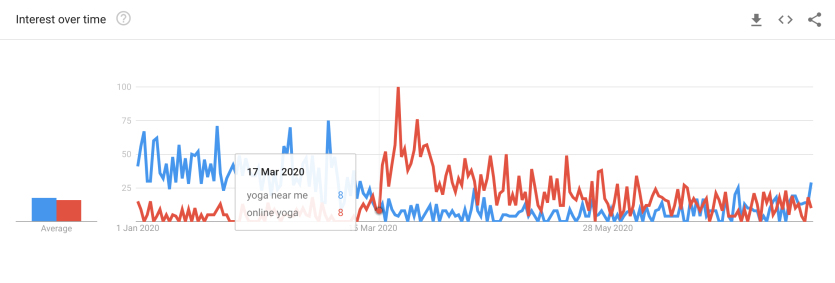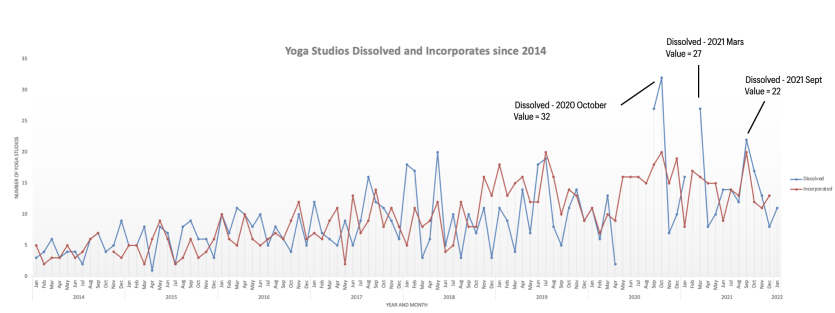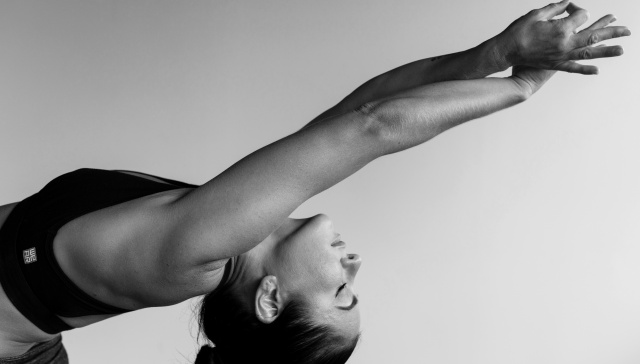Yoga studios in the UK: impact of lockdown and other UK studios stats and data
Back in March 2020 yoga studios had to close down as requested by the government, and people started searching for "online classes" instead of "yoga near me" on Google:

The yoga industry was broken before the lockdown
Yoga is the only sport (and of course it’s more than a sport) that doesn't have any kind of competition, race or tournament, and yoga is not featured in the Olympics. As a student, you don't even get a reward when you reach a certain level!
No teams, no countries represented, no fans, not much merchandising, no advertising revenue = no money to finance yoga practice centres.
Studio owners must invest their personal funds in their studio, making it hard to be profitable. (£55K is the minimum you need to start a studio). Studio owners have to find solutions to make it work:
- The studio owner is usually the teacher with the most classes at the studio to avoid having to pay for teachers
- Studios often offer a high proportion of beginner classes to attract new students, and only a few advanced ones
- Studios make more money from teacher training than student teaching, so they sometimes offer teacher training classes instead of student classes
Teachers find it hard to live off teaching yoga
Yoga teachers can’t find enough studios to teach. They spend a lot of time travelling from one studio to another. They don’t always get paid well, making it hard for them to live off their practise. The lack of regulation in teacher training also results an overcapacity of yoga teachers.
High prices and limited choice for students
Prices are often high, and the choice of type of yoga, teacher and level is limited. Students have to travel far away to find the right teacher and the right level - often ending up having to buy 10 class passes in 3-4 different studios.
COVID-19 lasted longer than the government's help
When the full lockdown was in effect and for about one year, studios got help like any other businesses: furlough scheme, bounce back loans, council help, and other grants. Some yoga studios also made some substantial revenue from online classes.
But recovery was too slow for smaller studios and many had to close, for example, Yoga Base in Islington, Yoga Place on Bethnal Green Road, Life Centre in Islington, or Tooting Iyengar Centre - in London alone.
Bigger studios managed to negotiate further with their landlords and investors and are trying to stay afloat in the UK, but we can already see worrying trends:
Yoga Works closed all its 60 locations in the US
Tigre Yoga closed 5 out of 8 locations in France
Our survey reveals that 9% of teachers have seen their studio close permanently.
A surge in dissolved yoga studios from October 2020
There is very little data available about yoga. Finder mentions 10,000 teachers and half a million practitioners. But we don't know how many yoga studios existed before the pandemic. We extracted data for the company house website (any company with the word yoga or yogi in its name), but unfortunately, the data is missing for the most crucial months. It would be very interesting to compare it with other industries like hair salons or restaurants and pubs.

Livestream Yoga: a new channel to teach
We created Live Yoga Teachers to make it easier for teachers to teach online and for students to attend online classes. We enjoyed practising Iyengar during lockdown, and we believe live-stream yoga is here to stay!
In the current situation, where studios are scarce, live stream can help democratise the yoga industry.
 Live Yoga Teachers
Live Yoga Teachers
